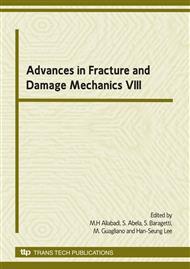p.9
p.13
p.17
p.21
p.25
p.29
p.33
p.37
p.41
On the Use of the Theory of Critical Distances to Estimate KIc and ∆Kth from Experimental Results Generated by Testing Standard Notches
Abstract:
The present paper is concerned with the use of the Theory of Critical Distances (TCD), applied in the form of the Point Method (PM), to estimate the range of the threshold value of the stress intensity factor, Kth, as well as the plane strain fracture toughness, KIc. In more detail, by reanalysing a large amount of experimental data taken from the literature, it is proved that Kth can successfully be evaluated through the plain fatigue limit and another fatigue limit generated by testing samples containing a known geometrical feature, whereas KIc is suggested here as being estimated by using experimental results generated by testing samples weakened by notches of different sharpness. The validation exercise summarised in the present paper fully confirms that the TCD is not only a reliable method suitable for performing the static and fatigue assessment of real components, but also an efficient experimental strategy capable of accurately estimating the classical Linear Elastic Fracture Mechanics (LEFM) material properties.
Info:
Periodical:
Pages:
25-28
Citation:
Online since:
October 2009
Authors:
Price:
Сopyright:
© 2010 Trans Tech Publications Ltd. All Rights Reserved
Share:
Citation:


